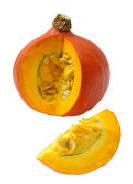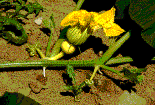Pumpkin
Information about Pumpkins plus Pumpkin Recipes
Collection
|
Ingredient of
the
MonthÂ
|
Scroll
down for Pumpkin recipes
|
NovemberÂ
2001 |
Click
here for
moe Ingredients of the Month
Â

    Â
Olga Shelego - Fotolia.com |
Pumpkins
belong to the Cucurbitaceae family, which includes cucumbers,
melons, squash, and gourds. Within this family is the genus Cucurbita which
includes all varieties of pumpkin.
Â
Pumpkins
are available in all shapes, colours and sizes, but one of the best known
is the Jack 'o Lantern pumpkin C.Pepo, which can weigh as much as
100 pounds and is popular for carving at Halloween.
|
Origins
and History of Pumpkins
Â
Â
The word pumpkin comes from
the Greek pepon for a large melon. The English named it pumpion or
pompion, a term which dates back to 1547.
Cultivated Pumpkins are believed to have originated in Central America
and seeds from related plants found in Mexico date back to 5500 B.C.
When the first settlers landed in the US, they found Native American
Indians using pumpkin as a staple in their diets. It soon became a
staple in the settlers' diets, too and the seeds were brought back to
Europe, where pumpkins soon became popular. The origins of wild form is
uncertain.
Pumpkins are now grown all over the world with Antarctica being the sole
exception.
Â
Halloween
and Pumpkins
Â
 As
folk lore would have it, the Jack 'o Lantern was named after a man called
Jack, who was an infamous drunkard and trickster. He tricked Satan into
climbing a tree then carved an image of a cross in the tree's trunk,
thereby trapping the devil up the tree. He made a pact with the devil
that, if the devil would never tempt him to wicked ways again, he would
promise to let him down the tree. As
folk lore would have it, the Jack 'o Lantern was named after a man called
Jack, who was an infamous drunkard and trickster. He tricked Satan into
climbing a tree then carved an image of a cross in the tree's trunk,
thereby trapping the devil up the tree. He made a pact with the devil
that, if the devil would never tempt him to wicked ways again, he would
promise to let him down the tree.
Â
However,
after Jack died, not only was he was denied in to Heaven because of his
previous evil ways but was also denied access to Hell because he had
tricked the devil. The devil instead gave him a single ember to light his
way through the darkness. This was placed inside a hollowed-out turnip to
keep it glowing longer.
Â
Halloween
spread throughout Europe in the seventh century and began with "All
Hallows Eve", the "Night of the Dead" (31st October) . It's
not certain when turnips were replaced by pumpkins, but this was probably
because they were larger and much easier to carve. European custom
included the lighting of pumpkins with scary faces to ward of evil spirits
who roamed abroad during All Hallows Eve.
Â
Â
Cultivation
of Pumpkins
Â
 Pumpkins
grow on vines on the ground. Seeds are planted from the last week of May
to the middle of June, and germinate in about 7-10 days. During this time,
seeds need moisture and warmth. Pumpkins
grow on vines on the ground. Seeds are planted from the last week of May
to the middle of June, and germinate in about 7-10 days. During this time,
seeds need moisture and warmth.
Â
Once
seeds have germinated, they will send up their first leaves, called seed
leaves. The true leaves appear next and then yellow flowers blossom start
to appear about 4 weeks later, first the male flowers then about a week
later, the female flowers. Once both male and female blossoms appear on
the vine, bees transfer the pollen between the two.
Â
It
takes 90-120 days for a pumpkin to grow after it has been planted. The
plants frequent watering during their growing period. Ripe pumpkins are
harvested in October. Ripe pumpkins contains seeds, which can be saved to
grow new pumpkins the following year.
Â
Â
|
|


 As
folk lore would have it, the Jack 'o Lantern was named after a man called
Jack, who was an infamous drunkard and trickster. He tricked Satan into
climbing a tree then carved an image of a cross in the tree's trunk,
thereby trapping the devil up the tree. He made a pact with the devil
that, if the devil would never tempt him to wicked ways again, he would
promise to let him down the tree.
As
folk lore would have it, the Jack 'o Lantern was named after a man called
Jack, who was an infamous drunkard and trickster. He tricked Satan into
climbing a tree then carved an image of a cross in the tree's trunk,
thereby trapping the devil up the tree. He made a pact with the devil
that, if the devil would never tempt him to wicked ways again, he would
promise to let him down the tree. Pumpkins
grow on vines on the ground. Seeds are planted from the last week of May
to the middle of June, and germinate in about 7-10 days. During this time,
seeds need moisture and warmth.
Pumpkins
grow on vines on the ground. Seeds are planted from the last week of May
to the middle of June, and germinate in about 7-10 days. During this time,
seeds need moisture and warmth.